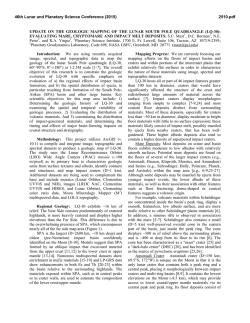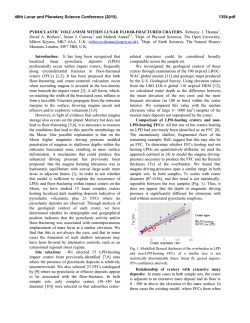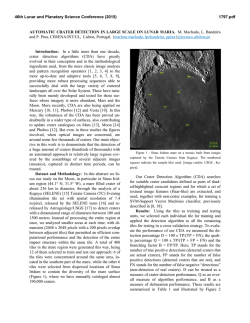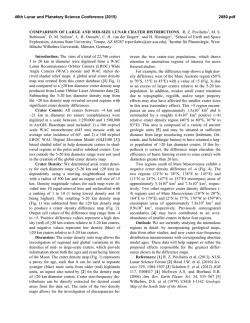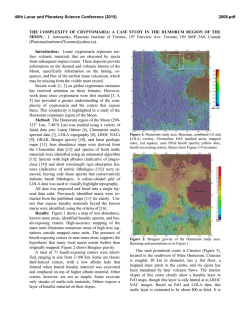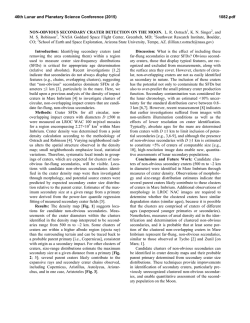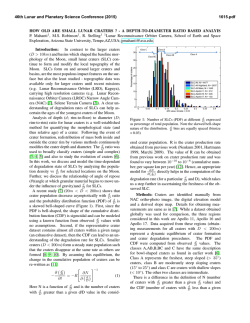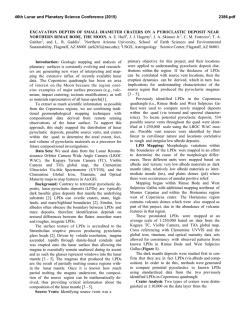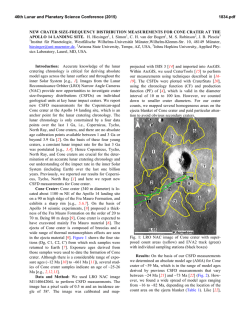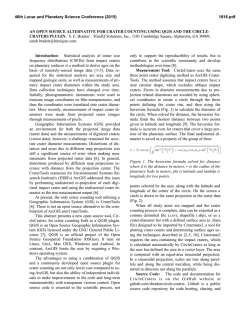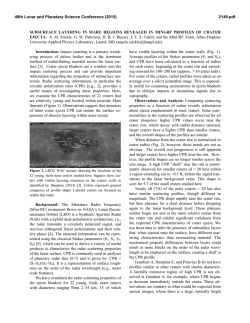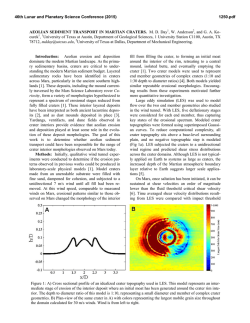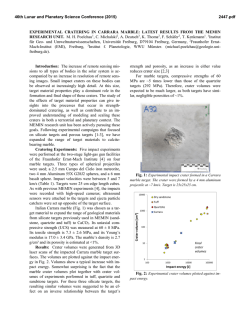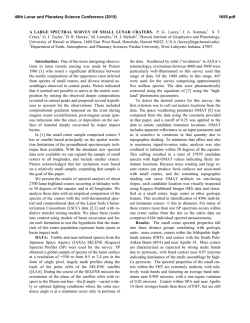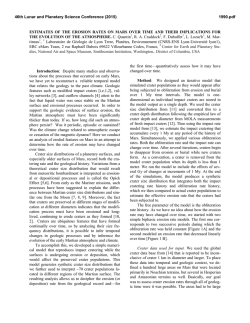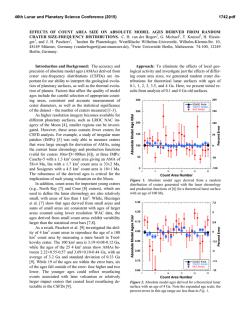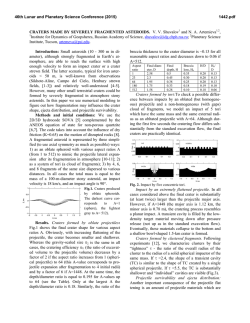
Young Lunar Mare Deposit at Flamsteed Indicated From Surface
46th Lunar and Planetary Science Conference (2015) 1320.pdf Young Lunar Mare Deposit at Flamsteed Indicated From Surface Radar Echo and Crater Degradation State. Junichi Haruyama1, Takao Kobayashi2, Atsushi Kumamoto3, Aoi Aritomi4, Hiroaki Kimura4 and Wataru Miyake4. 1 Japan Aerospace Exploration Agency, Institute of Space and Astronautical Science / JAXA Space Exploration Center, 3-1-1 Yoshino-dai, Chuo-ku, Sagamihara, Kanagawa 252-5210, Japan. TEL: +81-50-3362-4539, E-mail: haruyama.junichi_at_jaxa.jp (change “_at_” to “@”), 2 Korea Institute of Geoscience and Mineral Resources, Geological Survey Dept. 3 Tohoku University, Science Dept. 4 Tokai University, Engineering Dept. Introduction: The model ages of lunar mare deposits have been re-estimated with global high-resolution imaging data [e.g., SELENE’s Terrain Camera (TC) and the Lunar Reconnaissance Orbiter Camera (LROC)’s Narrow Angle Camera (NAC)]. This reestimation, particularly for young mare units, is changing the view of the history of the Moon. Here, we propose a unique method to derive relative ages for lunar mare deposits using SELENE (Kaguya) Lunar Radar Sounder (LRS) echo data. Basalt flow areas expanding around Flamsteed crater, one of the youngest units (~1Ga old), are investigated. Mare deposits of ~2.5 Ga were found in the SouthPole Aitken (SPA) basin [1], the Mare Moscoviense [1], and Tsiolkovsky crater [2] on the lunar farside. Much younger mare deposits that erupted1.7 Ga ago have been discovered between the Australe and the SPA basin [3]. The youngest mare volcanisms on the nearside were identified on the plane in the southern area of the Aristarchus plateau and found to be 1.2Ga old and 1.3Ga old in the western area of Flamsteed crater [4]. Morota et al. (2011) [5] re-estimated the model ages of the areas to be 1.5Ga and 1.3Ga for the southern Aristarchus plateau and western Flamsteed crater [5]. Recently, Barden et al. (2014) [6] estimated the model ages of irregular mare patches (IMPs) (e.g., Ina on 18.65° N, 5.30° E) to be 100 million years. Identification of younger mare deposits is often difficult. Researchers must extract target regions in imaging data and count many craters to estimate model ages in each region. However, recent globally collected data is changing this situation. All craters on the entire surface of the Moon have been catalogued. Fassett and Thomson (2014) [7] used catalogued craters ranging from 800 m to 2 km in diameter on mare regions that were identified in LRO WAC data to provide the density distribution of crater size range in moving neighborhood areas of 50 km radius, and converted it to a model age map. This map is consistent with the results of previous work and provides far more information on the variation in crater densities in the lunar mare regions. Furthermore, they provided the global distribution of crater degradation states in craters ranging in diameter from 800 m to 2 km, based on the TC Digital Terrain Models (DTMs) and converted implied model ages. Independently obtained model age maps, one from crater size distribution and another from crater erosion (degradation) states, correlate well; however, they exhibit slight differences at several locations. These differences may be due to secondary craters, the size of the area used to count the number and degradation stage of craters, and/or an application limit of crater chronology and the diffusion theory for crater erosion (degradation). LRS Data: The LRS transmitted HF band (center frequency 5 MHz; wavelength 60 m) electromagnetic waves using one set of dipole antennas (tip-to-tip length 30 m), and received echoes that reflected from the lunar surface and subsurface boundaries. The LRS sampling interval was 50 msec, corresponding to 76 m distance on the surface of the Moon. Subsurface echoes provide information on the structure at a depth of a few hundred m to a few km under the ground. Various results have been presented using these echoes. However, here we use the surface echo of LRS. Reflected echoes from the surface are mixed waves from the top surface and the bottom of an underlying regolith layer with a delay, and are often weakened. In principle, the greater the regolith thickness, the weaker the powers of returned echoes become. Locations Returning Higher LRS Echoes: We investigated the locations returning higher LRS surface echoes that are assumed to have a relationship with thinner regolith layers formed on young mare basalt flows. Figure1 presents a radar echo map derived from LRS active sounding experiments. The highest returning echo regions at longitude λ and latitude φ are 1) 31.5°W <λ< 31.0°W, 39.5°N <φ< 40.0°N, 2) 43.0°W <λ< 42.5°W, 4.0°S <φ< 3.5°S, 3) 133.5°E <λ< 134.0°E, 51.5°S <φ< 51.0°S. Location 1 is in the Mare Imbrium. Bugiolacchi and Guest (2008) [9] estimated the region (classified as “9i” in their paper) to be 2.2Ga, the youngest area in the Mare Imbrium. Location 2 is at the Flamsteed crater, where previous works indicated coverage by young mare basalts formed 1.3Ga ago [4,5,7]. Location 3 is on the north area of the Planck crater in the SPA on the lunar farside SPA. In this paper, we report on Location 2, the Flamsteed basalt-covered area. Young Lunar Mare Deposit at Flamsteed: We reestimated the model ages of the Flamsteed areas to find the youngest mare deposit by crater counting based on SELENE (Kaguya) TC imaging data. We referred SELENE Multi-band Imager (MI) visible band data to define geological units, each of which is assumed to be 46th Lunar and Planetary Science Conference (2015) Fig.1. SELENE Lunar Radar Sounder (LRS) surface echoes on the Moon. The yellow circles indicate the locations of the highest echoes, possibly corresponding to the youngest mare deposits. covered by the same basalt that erupted in the same age. Our estimation for the areas is 1.18Ga for the Neukum model age, one of the youngest mare deposits. We investigated the degradation states of craters superposed on the area. Soderblom (1970) [11] proposed a crater degradation model based on an analytic theory of meteorite impact cratering erosion, expressed by a simple diffusion equation for change of crater interior slopes. An approximate solution is 1320.pdf pressed by F min , is lower, consistent with the result from crater chronology. The degradation state expressed by F min is a useful indicator to determine the relative age of each geological unit because it is not influenced by secondary craters that often lead to wrong estimation of model ages from crater size distribution. Here, we note that the curve of F min often does not fit for the highest depth/diameter crater of more than several hundred meters in diameter in some regions. We may have counted craters for different age units, or the degradation state may not be expressed using the simple erosion model derived by Soderblom (1970) [11] for larger craters exceeding several hundred meters. The radar surface echo power data and F min value data derived from the degradation state for smaller craters of a few to several hundred meters diameter may be good indicators for identifying young mare deposits. Both data are currently available for most areas of the Moon. 1 (1) , where S is the maximum interior slope (tangent of slope angle) after a net (micro)meteorite flux F has accumulated on a crater of diameter D, which was initially at a slope S i ; and α2 is a constant [12]. This plain expression tells us that the maximum degradation states or the minimum depth-to-diameter ratio of each crater size should have the same F value (F min ) in a geological unit, which should correspond to the age of the unit. We plotted depth/diameter vs diameter of craters for several lava units and found that a “cut-off” curve does exist in each unit, expressed by the above exponential using F min . In a region inside Flamsteed crater, however, there seems to be two cut-off curves: F min = 0.30 and 0.34, though these F min values both indicate the region should be very young (see Figure 2). Discussion and Conclusion: The LRS surface echo is a good indicator of lunar mare deposit age, although the indication may have some inaccuracy due to deposit material. One of the youngest regions indicated by high LRS echoes exists in the Flamsteed mare deposit area, as previous works suggest. The re-estimated age for some extracted units in the area as a similar deposit by MI data is 1.18Ga, based on crater counting using TC imaging data. The maximum degradation state for a few hundred meters to several hundred meters, ex- Fig.2. Crater depth to diameter ratio (d/D) vs diameter (D) inside Flamsteed crater. Curves (green: Fmin= 0.30; red: Fmin = 0.34) fit the points corresponding to the most degraded craters with the smallest d/D after adjusting only parameter F of equation (1) in the text. References: [1] Haruyama J., et al. (2009), Science 323, 905-908, [2] Morota et al. (2010), 43rd LPSC #1309, [3] Packert J. H., et al. (2012), 45th LPSC #1968, [4] Hiesinger H. J., et al. (2003), JGR 108 (E7), 5065, doi:10.1029/2002JE00198, [5] Morota T., et al. (2011), EPSL 302 (3-4), 255-266, [6] Barden S. E., et al. (2014), Nature Geo 7, doi:10.1038 /NGEO2252, [7] Fasset C. I. and B. J. Thomson (2014), JGR planets 119, doi:10.1002/2014JE004698, [8] Ono T., et al. (2010), SSR 154, 145-192, doi:10.1007/s11214-010-9673-8, [9] Bugiolacchi R. and J. E. Guest (2008), Icarus 197, 1–18, [10] Soderblom L. A. (1970), JGR 75, 2655-2661, [11] Soderblom L. A. and Lebofsky L. A. (1972), JGR 77, 279-2964.
© Copyright 2025
